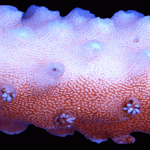
The 'Field of Streams', a map of stars in the halo of the Milky Way, covering about a fifth of the night sky, as observed by SDSS. The trails and streams crossing the image are stars ripped from Milky Way satellites by the tidal forces of our Galaxy. The colour of features corresponds to distance, with red being the most distant and blue the closest. Image: V. Belokurov/Sloan Digital Sky Survey
Large galaxies such as our Milky Way are believed to form through mergers and accretions of smaller galaxies.
In this scenario, evidence of individual accretion events (or “meals”) should be seen to this day, in the form of streams of stars left behind when small satellites are torn apart by the tidal forces of their larger (and still growing) neighbour. Stunning evidence that this process of galaxy cannibalism is still underway was uncovered with the 1994 discovery of the Sagittarius dwarf, a small galaxy being shredded by the Milky Way’s gravity, with long streams of stars extending all along
its orbit. More recently, data from the Sloan Digital Sky Survey — a project to map more than a quarter of the northern sky — has revealed just how messy our Galaxy’s eating habits are. An international team found that the Sagittarius stream appeared to fork in two, and detected numerous other stellar streams and structures criss-crossing the sky, leading them to dub the surveyed area the “˜Field of Streams’. The discovery of so many stellar streams was something of a surprise.
Skymapper, an Australian project to map the southern sky, will provide a more comprehensive picture, yielding more details of the Milky Way’s ongoing cannibalistic behaviour, and probably more than a few new surprises.
By Dr Daniel Zucker, Department of Physics and Astronomy, Macquarie University, and the Australian Astronomical Observatory.






